Improving Emission Uniformity of InGaN/GaN-Based Vertical LEDs by Using Reflective ITO/Ag n-Contact
Abstract
1. Introduction
2. Materials and Methods
3. Results and Discussion
4. Conclusions
Supplementary Materials
Author Contributions
Funding
Data Availability Statement
Conflicts of Interest
References
- Kneissl, M.; Seong, T.-Y.; Han, J.; Amano, H. The emergence and prospects of deep-ultraviolet light-emitting diode technologies. Nat. Photon. 2019, 13, 233–244. [Google Scholar] [CrossRef]
- Lee, B.-R.; Park, J.-H.; Kim, T.-G. Micro-light-emitting diode with n-GaN/NiO/Au-based resistive-switching electrode for compact driving circuitry. J. Alloys Compd. 2020, 823, 153762. [Google Scholar] [CrossRef]
- Song, J.-O.; Kwak, S.; Seong, T.-Y. Cu-doped indium oxide/Ag ohmic contacts for high-power flip-chip light-emitting diodes. Appl. Phys. Lett. 2005, 86, 062103. [Google Scholar] [CrossRef]
- Weisbuch, C. On The Search for Efficient Solid State Light Emitters: Past, Present, Future. ECS J. Solid State Sci. Technol. 2020, 9, 016022. [Google Scholar] [CrossRef]
- Hu, X.-L.; Xiao, F.-A.; Zhou, Q.-B.; Zheng, Y.-D.; Liu, W.-J. High-luminous efficacy green light-emitting diodes with InGaN/GaN quasi-superlattice interlayer and Al-doped indium tin oxide film. J. Alloys Compd. 2019, 794, 137–143. [Google Scholar] [CrossRef]
- Song, J.-O.; Kwak, S.; Park, Y.; Seong, T.-Y. Improvement of the light output of InGaN-based light-emitting diodes using Cu-doped indium oxide/indium tin oxide p-type electrodes. Appl. Phys. Lett. 2005, 86, 213505. [Google Scholar] [CrossRef]
- Jang, J.-S.; Park, S.-J.; Seong, T.-Y. Metallisation scheme for highly low-resistance, transparent, and thermally stable ohmic contacts to p-GaN. Appl. Phys. Lett. 2000, 76, 2898. [Google Scholar] [CrossRef]
- Taki, T.; Strassburg, M. Visible LEDs: More than Efficient Light. ECS J. Solid State Sci. Technol. 2020, 9, 015017. [Google Scholar] [CrossRef]
- Chu, J.-T.; Huang, H.-W.; Kao, C.-C.; Liang, W.-D.; Lai, F.-I.; Chu, C.-F.; Kuo, H.-C.; Wang, S.-C. Fabrication of Large-Area GaN-Based Light-Emitting Diodes on Cu Substrate. Jpn. J. Appl. Phys. 2005, 44, 2509–2511. [Google Scholar] [CrossRef]
- Uang, K.-M.; Wang, S.-J.; Chen, S.-L.; Yang, Y.-C.; Chen, T.-M.; Liou, B.-W. Effect of Surface Treatment on the Performance of Vertical-Structure GaN-Based High-Power Light-Emitting Diodes with Electroplated Metallic Substrates. Jpn. J. Appl. Phys. 2006, 45, 3436–3441. [Google Scholar] [CrossRef]
- Lee, S.Y.; Choi, K.K.; Jeong, H.-H.; Choi, H.S.; Oh, T.-H.; Song, J.O.; Seong, T.-Y. Wafer-level fabrication of GaN-based vertical light-emitting diodes using a multi-functional bonding material system. Semicond. Sci. Technol. 2009, 24, 092001. [Google Scholar] [CrossRef]
- Haerle, V.; Hahn, B.; Kaiser, S.; Weimar, A.; Bader, S.; Eberhard, F.; Plössl, A.; Eisert, D. High brightness LEDs for general lighting applications Using the new ThinGaN™-Technology. Phys. Status Solidi A 2004, 201, 2736–2739. [Google Scholar] [CrossRef]
- Kim, H.; Choi, K.-K.; Kim, K.-K.; Cho, J.; Lee, S.-N.; Park, Y.; Kwak, J.S.; Seong, T.-Y. Light-extraction enhancement of vertical-injection GaN-based light-emitting diodes fabricated with highly integrated surface textures. Opt. Lett. 2008, 33, 1273–1275. [Google Scholar] [CrossRef]
- Shchekin, O.B.; Epler, J.E.; Trottier, T.A.; Margalith, T.; Steigerwald, D.A.; Holcomb, M.O.; Martin, P.S.; Krames, M.R. High performance thin-film flip-chip InGaN–GaN light-emitting diodes. Appl. Phys. Lett. 2006, 89, 071109. [Google Scholar] [CrossRef]
- Laubsch, A.; Sabathil, M.; Baur, J.; Peter, M.; Hanh, B. High-Power and High-Efficiency InGaN-Based Light Emitters. IEEE Trans. Electron Devices 2010, 57, 79–87. [Google Scholar] [CrossRef]
- Han, J.; Lee, D.; Jin, B.; Jeong, H.; Song, J.O.; Seong, T.-Y. Optimizing n-type contact design and chip size for high-performance indium gallium nitride/gallium nitride-based thin-film vertical light-emitting diode. Mater. Sci. Semicond. Process 2015, 31, 153–159. [Google Scholar] [CrossRef]
- Luther, B.P.; Mohney, S.E.; Jackson, T.N.; Asif Khan, M.; Chen, Q.; Yang, J.W. Investigation of the mechanism for Ohmic contact formation in Al and Ti/Al contacts to n-type GaN. Appl. Phys. Lett. 1997, 70, 57–59. [Google Scholar] [CrossRef]
- Lin, M.E.; Ma, Z.; Huang, F.Y.; Fan, Z.F.; Allen, L.H.; Morkoc, H. Low resistance ohmic contacts on wide band-gap GaN. Appl. Phys. Lett. 1994, 64, 1003–1005. [Google Scholar] [CrossRef]
- Lester, L.F.; Brown, J.M.; Ramer, J.C.; Zhang, L.; Hersee, S.D.; Zolper, J.C. Nonalloyed Ti/Al Ohmic contacts to n-type GaN using high-temperature premetallization anneal. Appl. Phys. Lett. 1996, 69, 2737–2739. [Google Scholar] [CrossRef]
- Kim, T.K.; Cho, M.U.; Lee, J.M.; Cha, Y.-J.; Oh, S.K.; Chatterjee, B.; Ryou, J.-H.; Choi, S.; Kwak, J.S. Improved Light Output Power of 16×16 Pixelated Micro-LEDs for Headlights by Enhancing the Reflectivity and Coverage of the p-Electrode. Phys. Status Solidi A 2018, 215, 1700571. [Google Scholar] [CrossRef]
- Takahashi, Y.; Kita, Y.; Uchida, M. Development of 288segments matrix ADB system with improved visibility and safety. In Proceedings of the 12th international Symposium on Automotive Lighting, Darmstadt, Germany, 21 August 2017; p. 323. [Google Scholar]
- Kim, D.W.; Lee, H.Y.; Sung, Y.J.; Yeom, G.Y. A study of transparent contact to vertical GaN-based light-emitting diodes. J. Appl. Phys. 2005, 98, 053102. [Google Scholar] [CrossRef]
- Hwang, J.D.; Yang, G.H.; Chang, W.T.; Lin, C.C.; Chuang, R.W.; Chang, S.J. A novel transparent ohmic contact of indium tin oxide to n-type GaN. Microelectron. Eng. 2005, 77, 71. [Google Scholar] [CrossRef]
- Song, J.O.; Ha, J.S.; Seong, T.-Y. Ohmic-Contact Technology for GaN-Based Light-Emitting Diodes: Role of P-Type Contact. IEEE Trans. Electron. Devices 2010, 57, 42–59. [Google Scholar] [CrossRef]
- Götz, W.; Johnson, N.M.; Walker, J.; Bour, D.P.; Street, R.A. Activation of acceptors in Mg-doped GaN grown by metalorganic chemical vapor deposition. Appl. Phys. Lett. 1996, 68, 667. [Google Scholar] [CrossRef]
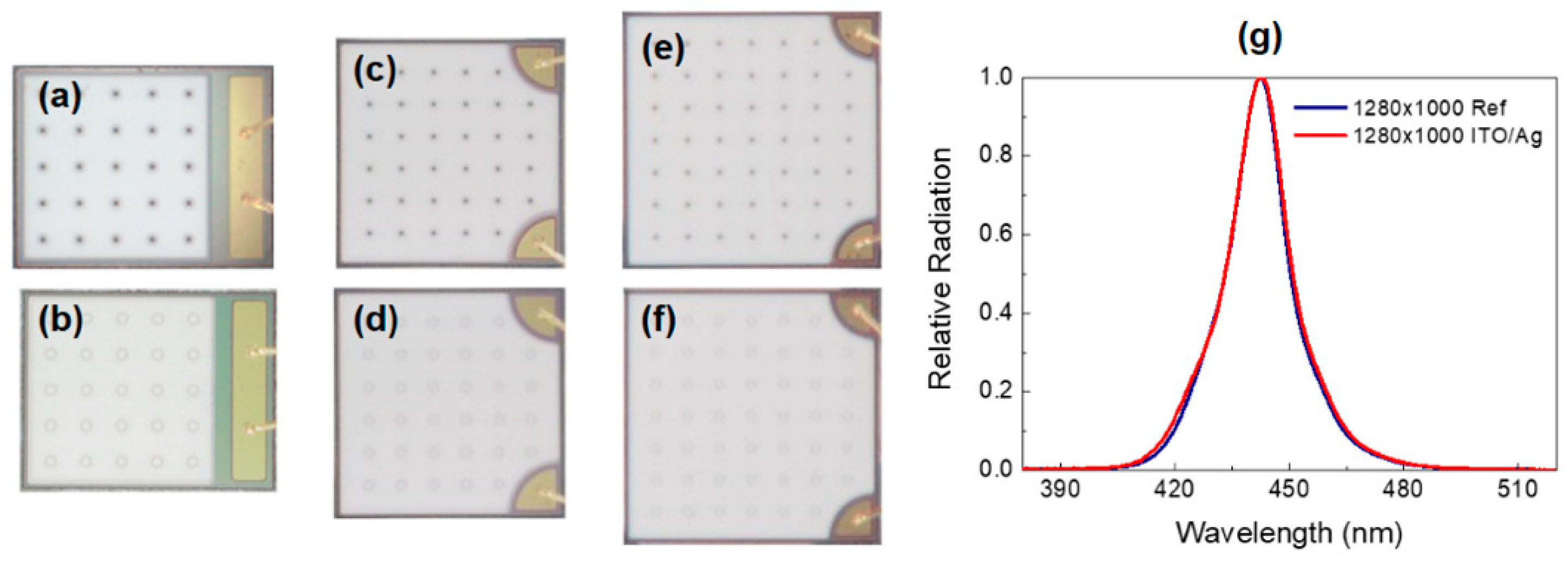

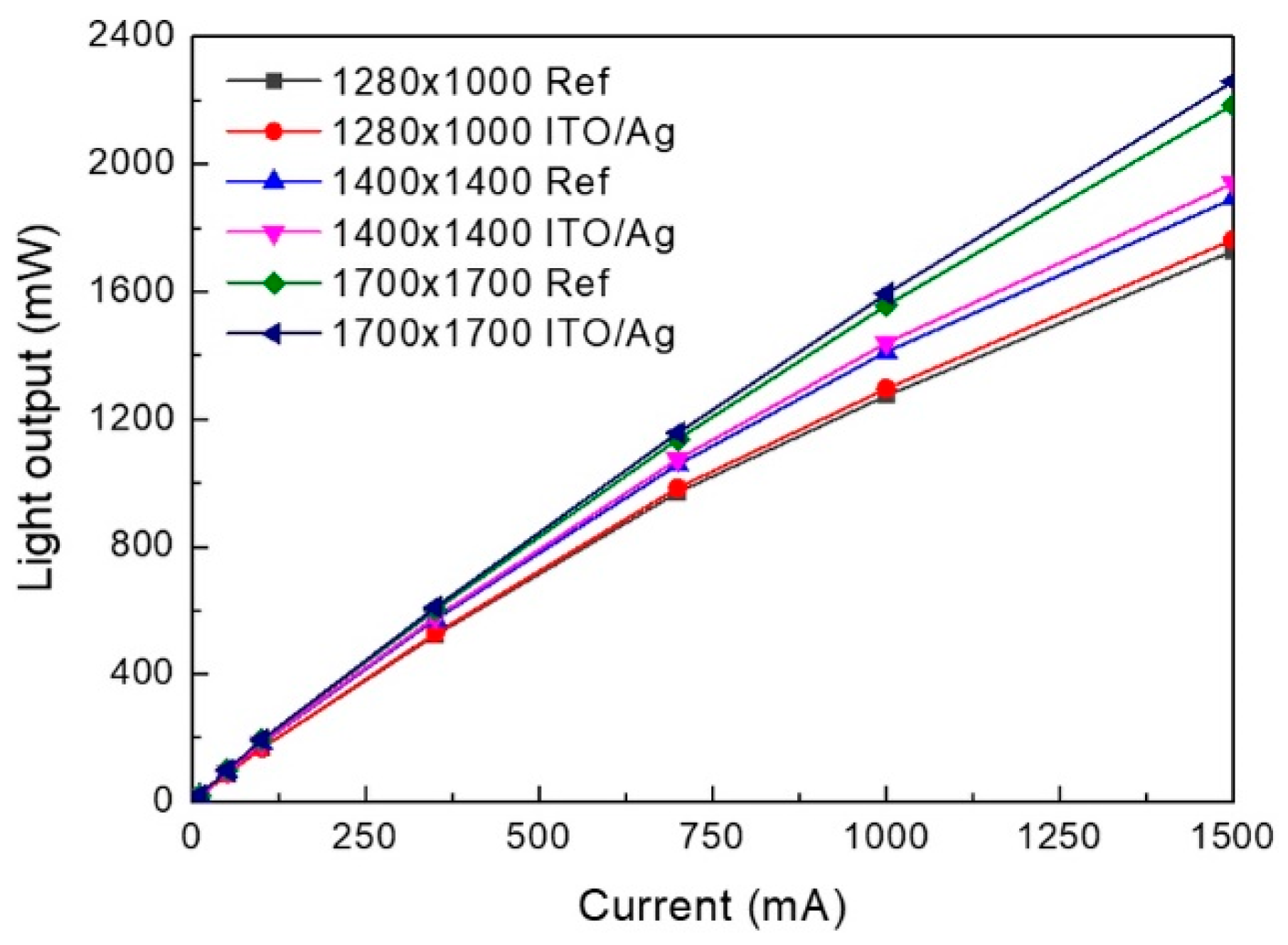

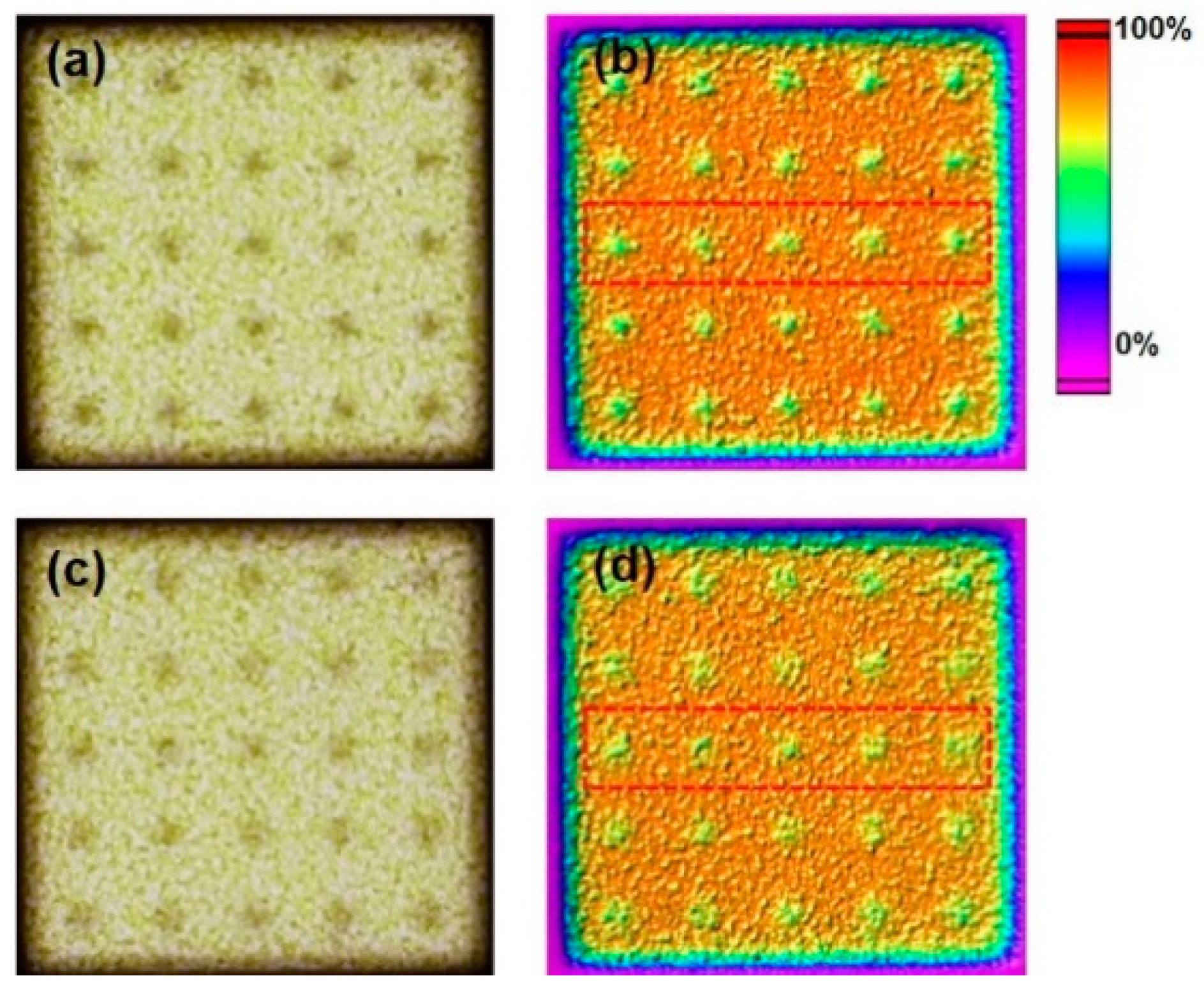
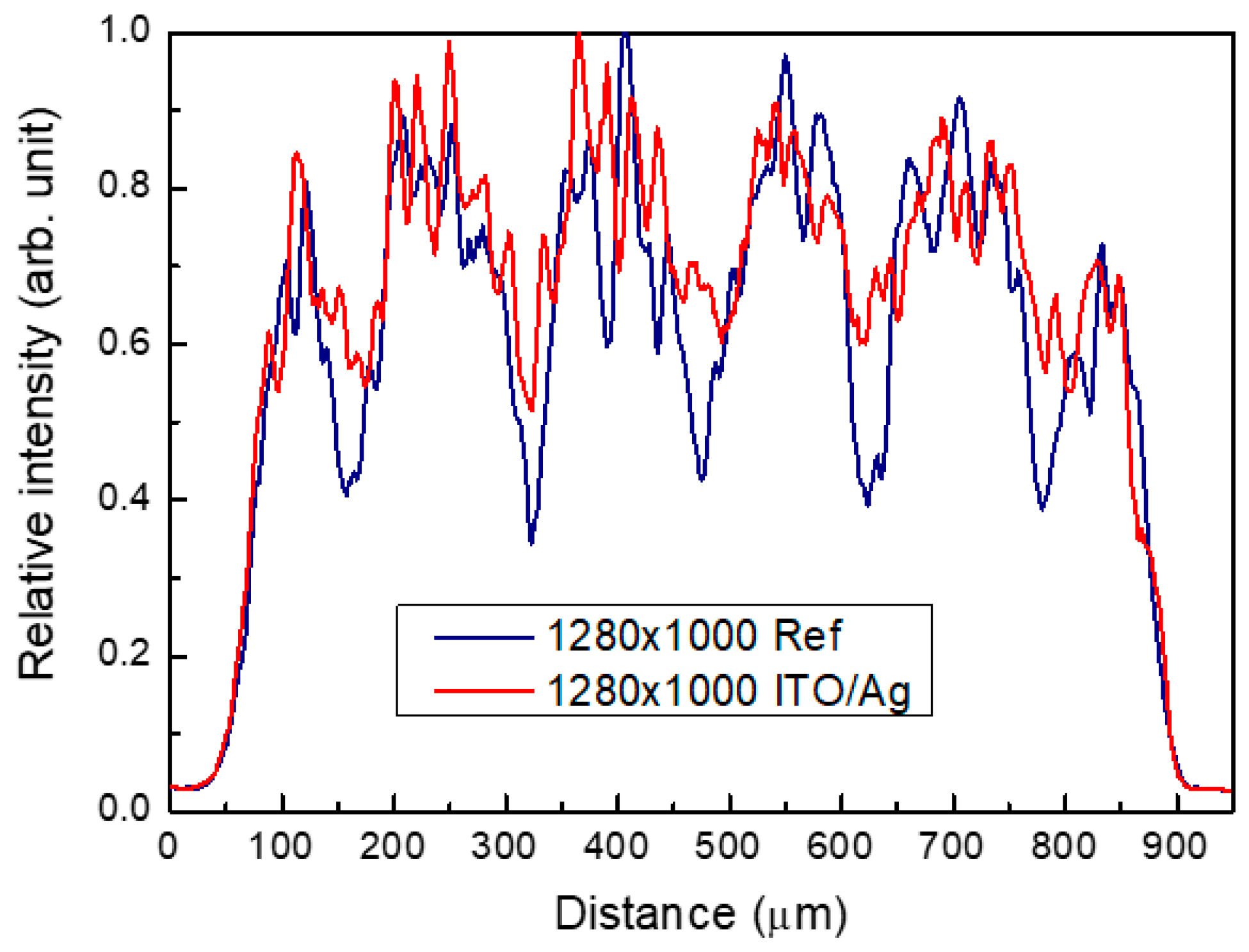
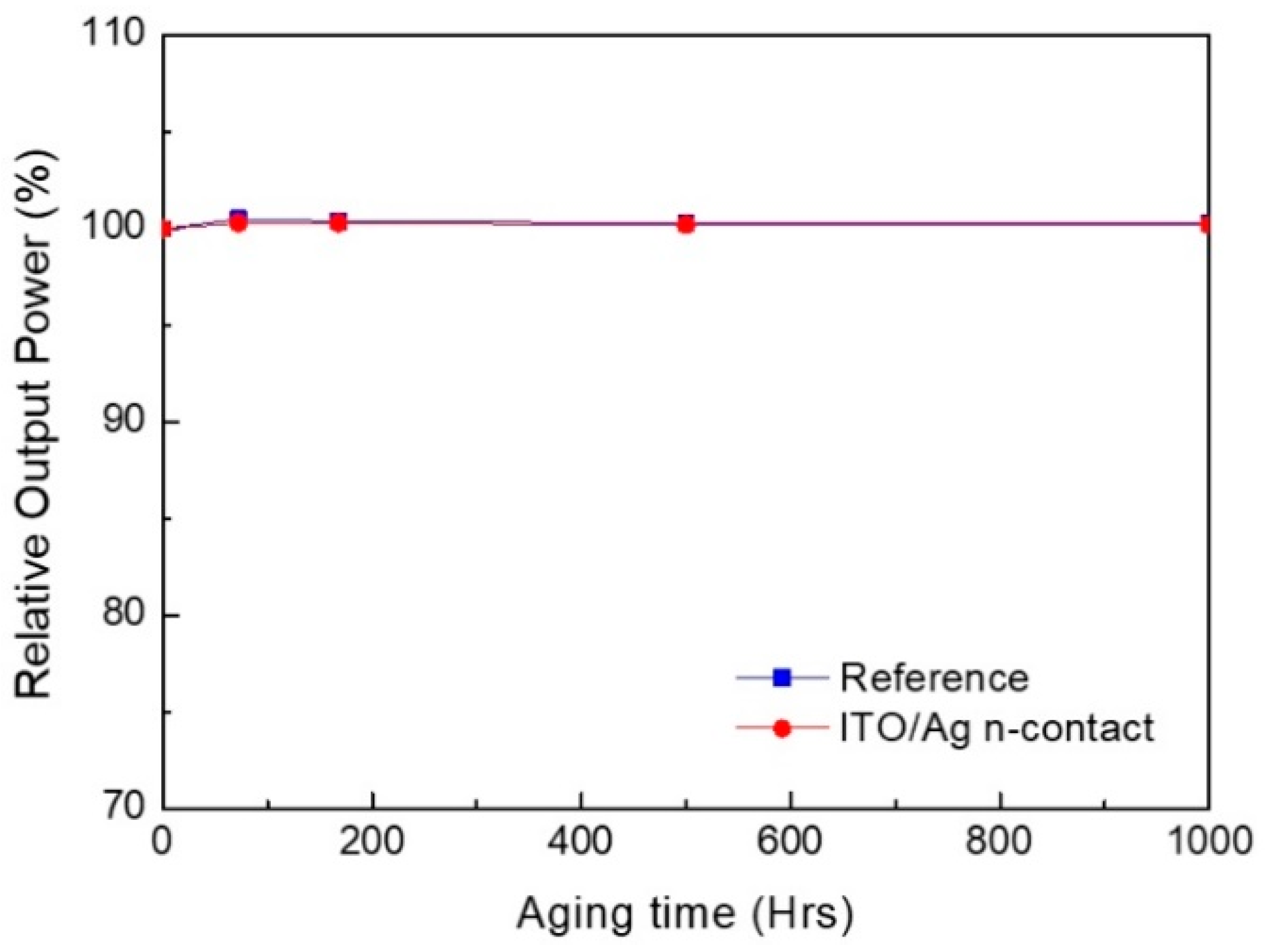
Publisher’s Note: MDPI stays neutral with regard to jurisdictional claims in published maps and institutional affiliations. |
© 2021 by the authors. Licensee MDPI, Basel, Switzerland. This article is an open access article distributed under the terms and conditions of the Creative Commons Attribution (CC BY) license (https://creativecommons.org/licenses/by/4.0/).
Share and Cite
Yum, W.-S.; Koo, J.-H.; Lee, D.-H.; Kim, Y.-H.; Jeong, Y.-K.; Jung, S.-Y.; Lee, S.-Y.; Jeong, H.-H.; Seong, T.-Y. Improving Emission Uniformity of InGaN/GaN-Based Vertical LEDs by Using Reflective ITO/Ag n-Contact. Electronics 2021, 10, 975. https://doi.org/10.3390/electronics10080975
Yum W-S, Koo J-H, Lee D-H, Kim Y-H, Jeong Y-K, Jung S-Y, Lee S-Y, Jeong H-H, Seong T-Y. Improving Emission Uniformity of InGaN/GaN-Based Vertical LEDs by Using Reflective ITO/Ag n-Contact. Electronics. 2021; 10(8):975. https://doi.org/10.3390/electronics10080975
Chicago/Turabian StyleYum, Woong-Sun, Ji-Hyun Koo, Dae-Hee Lee, Young-Hoon Kim, Young-Kyu Jeong, Se-Yeon Jung, Sang-Youl Lee, Hwan-Hee Jeong, and Tae-Yeon Seong. 2021. "Improving Emission Uniformity of InGaN/GaN-Based Vertical LEDs by Using Reflective ITO/Ag n-Contact" Electronics 10, no. 8: 975. https://doi.org/10.3390/electronics10080975
APA StyleYum, W.-S., Koo, J.-H., Lee, D.-H., Kim, Y.-H., Jeong, Y.-K., Jung, S.-Y., Lee, S.-Y., Jeong, H.-H., & Seong, T.-Y. (2021). Improving Emission Uniformity of InGaN/GaN-Based Vertical LEDs by Using Reflective ITO/Ag n-Contact. Electronics, 10(8), 975. https://doi.org/10.3390/electronics10080975





